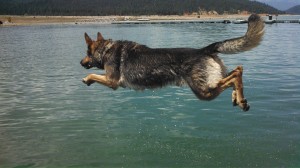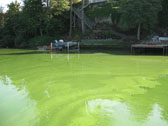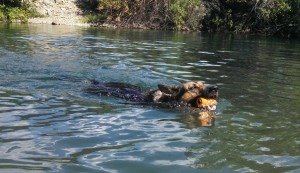Safe Swimming
Swimming with German Shepherds
For many German Shepherd Dogs, swimming tops the list as their favorite activity. Not only is swimming an excellent exercise for the dog, but it also keeps them cool, fit, and toned. And with the hot summer days of August and September ahead, no doubt many of us will be making trips to our favorite swimming spots with our dogs.
While swimming may be fun, it can also be a potentially dangerous activity. Hazards such as underwater debris and toxic algae blooms should make handlers think twice about taking their dogs to just any spot to swim. Before you pack up your dog and head out to the lake, river, or beach, check out some of our tips below for ensuring a safe swimming session with your dog.
Water Choice
Salt or freshwater? Freshwater is recommended, particularly since dogs do swallow quite a bit of water as they swim. Ingesting salt water can cause vomiting and dehydration, and excessive ingestion of salt water can cause severe neurological problems, including seizures and brain swelling. Additionally, ocean waves and currents can also make swimming difficult and dangerous for a dog, so if you are headed to the ocean, it may be wise to keep your dog on the beach and not out in the surf.
 Underwater Hazards
Underwater Hazards
Look before you let your dog leap! Take a brief scan of the entry and exit points of the water, and keep an eye out for hazards such as broken glass bottles, torn aluminum cans (very sharp!), fishing hooks and lures, and debris just under the water that can catch a paw or impale a leaping dog. Many dogs love to charge into the water, and if you plan on throwing sticks or toys out into the water for your dog to retrieve, you want to ensure there is nothing hiding under the surface that can hurt your dog as he blasts through.
Toxic Algae Blooms
 Toxic algae blooms occur in slow-moving, stagnant, warm bodies of freshwater. The warmer temperatures and nutrient runoff from surrounding homes or agriculture can cause the cyanobacteria in the water to grow and reproduce rapidly, creating these “blooms”, like the one pictured on the right (photo from Oregon Dept of Public Health). Should the bloom be toxic, the poison produced can kill a dog, and is difficult to treat once ingested. Of all the swimming hazards, this one is possibly the greatest, due to an inability to successfully treat most dogs that have ingested the toxins from the cyanobacteria.
Toxic algae blooms occur in slow-moving, stagnant, warm bodies of freshwater. The warmer temperatures and nutrient runoff from surrounding homes or agriculture can cause the cyanobacteria in the water to grow and reproduce rapidly, creating these “blooms”, like the one pictured on the right (photo from Oregon Dept of Public Health). Should the bloom be toxic, the poison produced can kill a dog, and is difficult to treat once ingested. Of all the swimming hazards, this one is possibly the greatest, due to an inability to successfully treat most dogs that have ingested the toxins from the cyanobacteria.
Signs of cyanobacteria blooms include: cloudy water, blooms floating on the surface (they look like foam, scum, or mats on the surface), or a bad smell to the water. Some of the blooms look like paint floating in the water, as they come in a variety of colors, including blue, bright green, brown, or red. Photos of several different algal blooms can be found here.
In California, blue-green algal blooms have been reported before in several areas, including the Klamath River, Big Lagoon and Eel River, Clear Lake, Lake Isabella, Crowley Lake, Lake Elsinore, San Francisco Bay Delta, Stockton Channel, Pinto Lake, and the Van Duzen River. Most recently, reports of blue-green algal blooms have been reported in the Trinity River, influenced by the extremely low water levels due to California’s current drought. Oregon has also reported algal blooms at several lakes, including Lost Creek Lake, Odell’s Lake, Devil’s Lake, and Walterville Pond. Oregon Department of Public Health has created an information poster about dog safety and algal blooms to help inform pet owners of these blooms. Many states have a monitoring system set up to keep track of potential toxic algal blooms; when it doubt, check it out!
Ocean water can also have harmful algal blooms, creating a condition known as a “red tide”. If you are heading to the beach with your dog in the summer and early fall, check first to see if any warnings have been issued in the area you wish to visit.
Excess Water Ingestion
Most dogs ingest some water while they swim, but dogs who bite at the water or are retrieving objects in the water will swallow a great deal more than a dog who swims with their mouth closed. If the dog ingests too much freshwater within a period of time, a dangerous and potentially deadly condition known as water intoxication can occur. This causes excessively low sodium levels in the dog’s body; sodium is necessary for proper nerve impulse transmission, blood pressure regulation, and muscle function, and low sodium levels will create problems in all three areas. The excess water also causes cells to swell, including cells in the brain.
Signs of water intoxication in dogs include a loss of coordination, staggering, lethargy, vomiting, bloating, glazed eyes, and excessive salivation during or after a trip to the water. In severe cases, the dog can collapse, lose consciousness, fall into a coma, have seizures and breathing difficulties, and can even die.
Water intoxication can be prevented through careful monitoring of your dog’s swimming activities. Take periodic breaks to rest your dog during water play and to allow his body to process the ingested water before it reaches a dangerous level. Encourage him to urinate in a safe and out-of-the-way area to help flush the water out of his system. Consider bringing along a canine electrolyte solution that can be offered periodically to help maintain electrolyte balance (do not use zero calorie human “electrolyte” drinks made for humans, as some of these artificial sweeteners are toxic to dogs! Use a supplement specifically for dogs if an electrolyte solution is needed.).
Remaining mindful and conscientious about swimming your dogs–even if they are just swimming at home in the pool–will help ensure that this activity remains safe and enjoyable for all.


